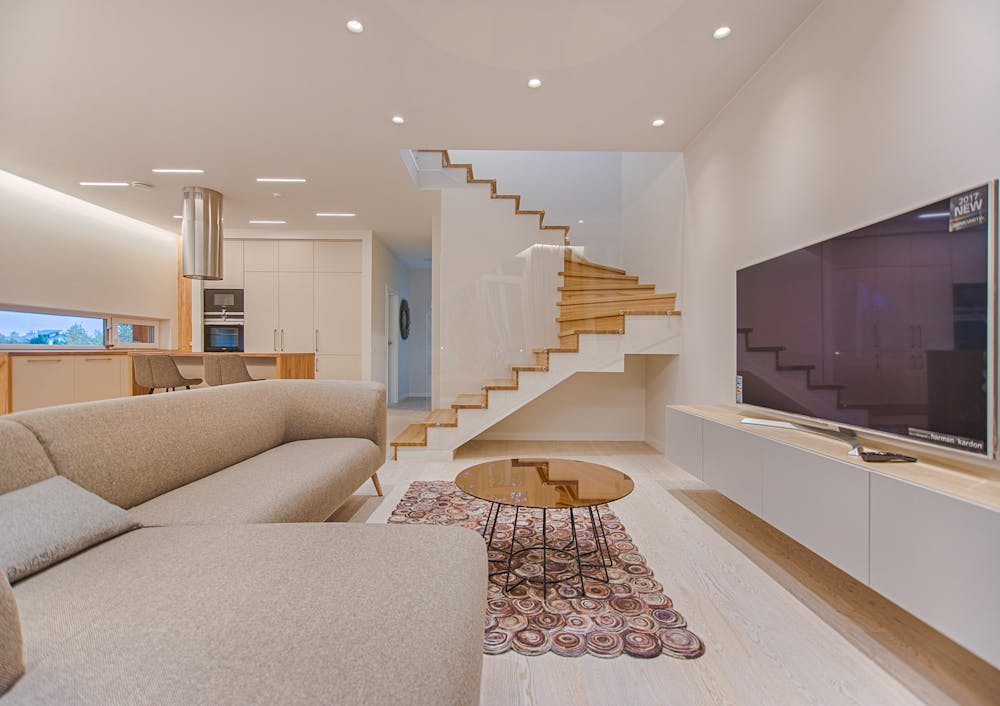In Florida, where the blend of bustling city life and serene beachfronts calls for a harmonious living environment, modern homes are designed to cater to both efficiency and comfort. The Sunshine State’s unique landscape has influenced how residential architecture integrates both style and functionality to accommodate diverse lifestyles. Modern homes here not only embrace cutting-edge technology but also ensure that residents can easily manage their daily routines, allowing them more time to enjoy the picturesque surroundings.
1. Smart Home Technology
One of the core features of modern homes that significantly simplifies life is smart home technology. This technology allows homeowners to control various systems within their house—from lighting and temperature to security cameras and entertainment systems—all through a single device, often a smartphone or tablet. For instance, smart thermostats adjust the temperature based on daily routines and preferences to optimize comfort and energy usage, while smart lights can be programmed to switch on and off as residents move through their home, ensuring convenience and energy efficiency. These integrated systems not only save time but also contribute to substantial cost savings on utility bills.
2. Efficient Use of Space
Modern homes are designed to make the best use of available space, which is particularly important in urban areas where space is at a premium. Multi-functional furniture and clever built-in storage solutions, such as under-stair drawers and overhead compartments, maximize living areas without cluttering them. These designs can transform small spaces into versatile environments. In terms of renovations, the typical Jacksonville bathroom remodel cost can depend on various factors including the choice of fixtures, the layout changes, and the quality of materials used, but the emphasis is always on maximizing functionality without sacrificing style.
3. Energy Efficiency
Energy efficiency is a hallmark of modern home design, which is not only good for the environment but also for the homeowner’s wallet. Modern homes often feature appliances and systems that are designed to use minimal energy while delivering maximum performance. Solar panels, high-efficiency washing machines, and LED lighting are common in these homes. Additionally, many new buildings include materials that improve insulation and windows that enhance thermal performance, reducing the need for excessive heating or cooling. This approach to energy efficiency ensures that homes are not only comfortable but also cost-effective to maintain.
4. Advanced Security Systems
The peace of mind that comes with living in a secure environment is invaluable, and modern homes often incorporate advanced security systems to ensure safety. These might include automated gate access, high-definition surveillance cameras, and alarms that can all be monitored and controlled remotely. This level of security is particularly important in areas with high traffic or where residents spend a lot of time away from home.
5. Healthier Living Environment
Modern homes also prioritize the health of their occupants. Improved ventilation systems that filter out pollutants and control humidity are standard, as are building materials that are free from harmful chemicals. These homes often use paints and finishes that are low in volatile organic compounds (VOCs) and install flooring that does not trap dust and allergens. By focusing on air quality and using hypoallergenic materials, modern homes help to prevent the health issues that can arise from poor indoor environments, ensuring that residents enjoy a cleaner, healthier living space.
6. Enhanced Entertainment Options
Modern homes are designed with entertainment in mind, incorporating advanced systems that cater to the digital age. Built-in sound systems and home theaters are common features, providing an immersive audio-visual experience without the need to leave the comfort of your home. These systems can be integrated seamlessly into the home’s design, with speakers hidden in walls and ceilings and screens that retract when not in use. This setup not only enhances the home’s functionality but also its aesthetic appeal, making it an ideal space for hosting gatherings or simply relaxing with family.
7. Maintenance and Durability
Durability and low maintenance are key characteristics of modern homes, reflecting a shift towards materials and technologies that offer longevity and require minimal upkeep. For instance, composite materials used in decking and siding resist weathering and decay much better than traditional wood, and do not require frequent painting or sealing. Similarly, modern roofing materials can last decades without needing significant repairs. These choices not only reduce the ongoing cost and effort associated with home maintenance but also contribute to the sustainability of the building.
8. Indoor-Outdoor Flow
The design of modern homes often emphasizes a seamless flow between indoor and outdoor spaces. Large sliding glass doors and continuous flooring that extends from inside to outside blur the lines between the two areas, enhancing the sense of space and bringing more natural light into the home. This connection to the outdoors is not just aesthetically pleasing but also expands living spaces physically and visually, making it easier to entertain guests or enjoy quiet time in a more natural setting, thereby enriching the everyday living experience.
9. Customization and Personalization
Today’s modern homes offer greater scope for customization and personalization than ever before, thanks to flexible floor plans and modular designs. Homeowners can choose layouts that best fit their lifestyle, whether they need more open spaces for entertaining, extra bedrooms for a growing family, or specialized rooms like home offices or gyms. This flexibility allows for a home that truly reflects the owner’s needs and style, making it easier to adapt to life’s changes without the need for costly renovations.
10. Technological Integration for Comfort
Modern homes use technology not just for convenience but also for comfort. Automated climate control systems adjust the temperature within the home to suit different times of the day or weather conditions, ensuring optimal comfort without constant manual adjustments. Automated window shades can be programmed to adjust based on sunlight exposure, reducing heat buildup and protecting interiors from UV damage. These technological integrations make managing home environments simpler and more efficient, allowing more time to enjoy the comforts of home.
Conclusion
The advancements in modern home design significantly enhance daily living by combining technological innovations, efficient use of space, and thoughtful integration of the indoor and outdoor environments. These homes not only cater to the practical aspects of living but also ensure that the space is adaptable, secure, and enjoyable. Embracing these modern elements can simplify maintenance, enhance entertainment, and provide personalized comfort, proving that a modern home is not just a place to live but a place that enhances the quality of life.





